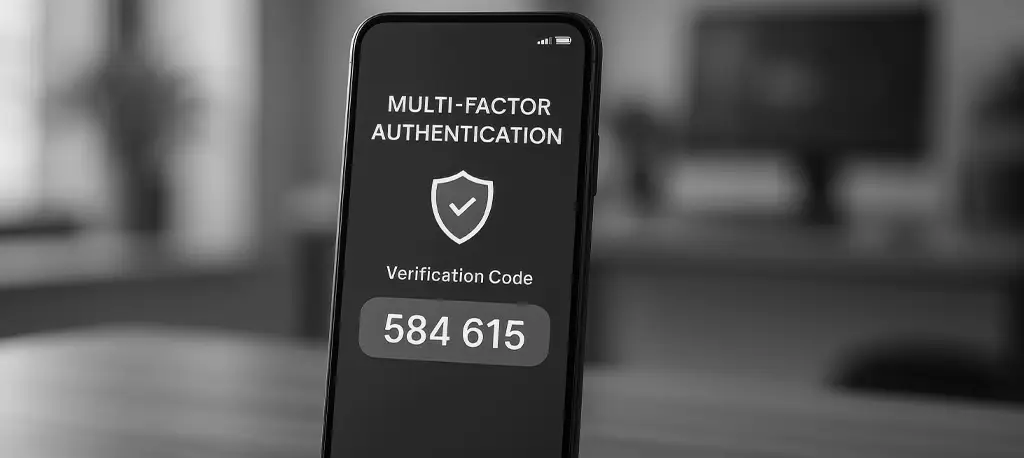Every click, search, and scroll you make online contributes to your digital footprint, which is a trail of data that reveals who you are, what you do, and where you’ve been on the internet.
There are two types: active digital footprints, created when you deliberately share information (like posting on social media), and passive digital footprints, collected silently through cookies, trackers, and apps without your direct input.
Keep in mind that your online presence can be exploited in ways that are often invisible until it’s too late, including privacy erosion, relentless targeted advertising, or even the growing threat of identity theft and scams.
So, how do you protect your digital footprint? You should reduce it by following practical safety tips, including smart behaviors, effective tools, and data removal strategies.
They will help you take control of your online identity and minimize your exposure, making you less vulnerable to potential threats.
Why Is Protecting Your Digital Footprint Important?
Your digital footprint is more than just a record of your online activity—it’s a blueprint of your identity. Leaving it unprotected can lead to serious consequences, many of which are difficult to reverse.
Identity Theft and Personal Data Exposure
Threat actors can piece together seemingly harmless information (like your email address, birthdate, or browsing habits) to commit identity theft, open fraudulent accounts, or gain unauthorized access to your financial data.
Social Engineering Risks
Hackers often use social engineering tactics (like phishing emails or fake login pages) powered by data from your digital footprint.
The more information available about you online, the easier it is for attackers to design believable schemes.
Long-Term Reputational Implications
What you post online today may resurface years later. Keep in mind that employers, colleges, and landlords may analyze your digital footprints to assess your character and credibility, so a single mistake can influence decisions that affect your future.
Growing Use of Personal Data by AI Models and Brokers
AI models and data brokers increasingly harvest personal data online, often without your consent.
This can pose privacy risks, fuel misinformation, and further limit control over how your identity is used on the Internet.
1. Audit Your Digital Presence
Before you effectively protect your digital footprint, you need to understand what’s already out there. A personal digital audit is the first step toward regaining control of your online identity.
Search Yourself Online
Start by searching your name on Google, Bing, DuckDuckGo, and other search engines. Use variations of your name, and include locations, usernames, or email addresses.
This helps you identify public-facing profiles, images, comments, and any outdated or unwanted content that may surface.
Set Up Google Alerts & Use “Results About You”
To stay informed, set up Google Alerts for your name or personal identifiers. This way, you’ll be notified when new content involving you appears online.
Additionally, you can use Google’s “Results About You” dashboard, which helps track and request the removal of sensitive personal information directly from search results.
Run Dark Web Scans
Use reputable dark web monitoring tools to scan this area for exposed emails, passwords, or other credentials linked to your identity.
Many data breaches go unnoticed, and early detection can help you change compromised logins before they’re exploited.
2. Tighten Your Privacy Settings Across Platforms
Once you’ve audited your online presence, the next step is to lock down your privacy settings across the platforms and tools you use every day.
Small changes can make a big difference in how much of your personal data is exposed and accessed.
Social Media
- Review and adjust audience settings on platforms like Facebook, Instagram, and X (formerly Twitter).
- Limit who can see your posts, tag you, or find you by email or phone number.
- Disable location sharing and remove geotags from past posts to prevent real-time tracking.
Here are our guides for some of the top social media channels:

Email Providers
- Enable spam filters and avoid clicking on suspicious links or downloading unknown attachments.
- For sensitive communication, consider using providers that offer end-to-end encryption, like ProtonMail or Tutanota.
Browsers
- Use privacy-focused browsers (like Brave or Firefox) and adjust settings to block third-party trackers and cookies.
- Add browser extensions like uBlock Origin or Privacy Badger to reduce data collection further.
Smartphone Apps
- Review your app permissions regularly.
- Refuse access to your camera, microphone, contacts, or location unless absolutely necessary.
- Uninstall apps you no longer use to limit passive data tracking.
3. Reduce Your Digital Footprint Proactively
Digital footprint safety tips aren’t just about tightening settings—you should also make smarter choices and proactively remove data you no longer need online.
Delete Old or Unused Accounts
Start by compiling a list of old or inactive accounts, such as outdated forums, shopping sites, or social networks. Use your inbox to search for phrases like “Welcome to,” “Account created,” or “Verify your email.” Then:
- Visit the website and log in (use password recovery if needed).
- Navigate to account settings or privacy options.
- Look for “Delete Account” or “Close Account” and follow the instructions.
- If no option exists, email customer support with a deletion request.
For added help, sites like JustDelete.me list direct account removal links for hundreds of services.
Use Guest Checkout
When shopping online, choose guest checkout over creating a new account.
This reduces the amount of data stored by retailers, and your exposure to any future data breaches.
Avoid Third-Party Logins
Signing in with Google or Facebook may seem convenient, but it grants third-party apps access to your profile, contacts, and behaviors.
For improved data protection, create unique logins for each service or use a privacy-focused password manager instead.
4. Strengthen Login Security
Strong login security is one of the most effective ways to protect your digital footprint.
Weak or reused passwords are among the top reasons accounts get compromised, often leading to dangerous data leaks.
Use a Password Manager
A password manager generates and stores unique, complex passwords for each of your accounts, so you don’t have to remember them all.
Trusted tools like 1Password, Bitwarden, and Dashlane encrypt your credentials and autofill them only on legitimate sites. This minimizes both password reuse and phishing risk.
Enable Multi-Factor Authentication (MFA)
MFA makes your online accounts more secure, as it requires a second confirmation of your identity, such as a text code, app notification, or biometric scan. This way, even if someone gets your password, they can’t log in without that second factor.
Enable MFA on all accounts that support it, especially email, banking, and cloud storage.

Avoid Reusing Passwords or Using Personal Info
Never use the same password across multiple accounts. Also avoid passwords that include your name, birthday, pet’s name, or other easy-to-guess information.
These can be cracked quickly using social engineering or brute-force tactics.
5. Mask Your Activity with Privacy Tools
To reduce your digital footprint even more effectively, you need to obscure your activity from trackers, advertisers, and malicious actors. Privacy tools can help you stay anonymous and limit the data trails you leave behind.
VPNs: When and Why to Use Them
A Virtual Private Network (VPN) encrypts your internet connection and hides your IP address, making it much harder for websites, ISPs, or hackers to trace your activity.
Use a VPN when browsing on public Wi-Fi, accessing geo-restricted content, or simply when you want to prevent location-based tracking. Trusted options include NordVPN, Mullvad, and Proton VPN.
Secure Browsers and Search Engines
Switch to privacy-first browsers like Brave or Mozilla Firefox, which block trackers and intrusive ads by default.
Pair them with private search engines like DuckDuckGo or Startpage, which don’t log your search history or personalize results using your data.
Disposable Emails for Sign-Ups
When registering for one-time services, use temporary or alias email addresses from tools like SimpleLogin, AnonAddy, or 10MinuteMail.
This prevents spam and reduces the number of databases storing your real contact info.
6. Control What You Share Online
One of the easiest ways to protect your digital footprint is to think before you share. Much of your personal data ends up online not through breaches, but through everyday oversharing.
Be Cautious with Personal Details
Seemingly harmless posts like your favorite pet’s name, the street you grew up on, or your mother’s maiden name can be exploited in security questions or social engineering attacks.
Always consider who might see what you post, even on private accounts.
Avoid Sharing Travel Plans or Sensitive Info
Resist the urge to post real-time travel updates, vacation countdowns, or photos while away. Broadcasting your location can signal that your home is empty.
Also, never post your home address, birthday, or personal identifiers that could be used to impersonate you.
Don’t Fall for “Fun” Quizzes and Surveys
Those viral “Which character are you?” quizzes or “Tell us your first car and high school mascot” posts often mask data collection schemes.
They can be used to guess passwords or build detailed profiles for scams and phishing.

7. Opt Out of Data Broker and Marketing Lists
Data brokers collect and sell your personal information, often without your knowledge. This includes your name, address, phone number, purchasing habits, and even inferred interests.
Opting out is an essential step in reducing your digital footprint and regaining privacy.
Remove Yourself from Major Data Brokers
Start by targeting the biggest players, like Spokeo, Whitepages, Intelius, and BeenVerified. Each site has a different process, but here’s a general step-by-step:
- Go to the broker’s opt-out or privacy page.
- Search for your name and location.
- Locate your profile and submit a removal request.
- Confirm your request via email (some require identity verification).
Set a reminder to check back periodically, as listings may reappear.
To simplify this process and make it more effective (especially if you represent a company), invest in a professional data broker removal service.
Use Opt-Out Services for Marketing Lists
Register with OptOutPrescreen.com to limit pre-approved credit and insurance offers, and sign up with DMAchoice.org to reduce junk mail from marketers.
These services are free, easy to use, and endorsed by major consumer protection organizations.
8. Automate Software & App Updates
Research shows that outdated software is one of the most common entry points for cyberattacks, and a major threat to your digital footprint.
Hackers constantly scan apps, operating systems, and browser extensions for known vulnerabilities. When software isn’t updated, it leaves the door open for exploits that can compromise your data, install malware, or grant remote access to your device.
Why It Matters
Many updates include critical security patches designed to fix newly discovered flaws.
Delaying or ignoring them (even for a few days) can put your entire digital identity at risk, especially if you’re using outdated antivirus software, browsers, or mobile apps.
How to Set Up Auto-Updates
To stay protected, enable automatic updates across all your devices and applications:
- Desktop: On Windows and macOS, turn on auto-updates in system preferences and software settings.
- Mobile Devices: Enable app auto-updates in the App Store or Google Play Store settings.
- Browsers & Extensions: Most modern browsers update automatically, but check that your extensions do as well.
9. Educate Others and Build Better Digital Habits
Protecting your data on the Internet isn’t a one-time fix, but an ongoing effort that becomes more effective when shared with others.
Promoting digital footprint safety tips at home, work, or school helps build a more secure online environment for everyone.
Promote Safety at Home or Work
Encourage coworkers and family members to use strong passwords, enable two-factor authentication, and avoid oversharing online.
Executive cybersecurity is especially significant, but all employees should be aware of good practices. If you’re in a leadership role, consider offering brief digital privacy workshops or sharing trusted resources.
Guide Kids and Elderly Relatives
Children and older adults are often the most vulnerable online. Teach kids to think twice before sharing photos or personal info, and help seniors identify phishing scams, set up privacy controls, and manage passwords safely.
Make It a Habit
Get in the habit of reviewing your digital footprint quarterly. Set calendar reminders to check privacy settings, delete unused accounts, and search for your name online.
How to Reduce Your Digital Footprint – Final Thoughts
Protecting and reducing your digital footprint requires both awareness and consistent actions.
You can take various measures to stay safer online, including regularly conducting online presence audits, tightening privacy settings, using privacy tools, and opting out of data broker lists.
Remember to take the necessary steps regularly to adapt to the dynamically evolving technologies and threats.
Start small. Pick one section from this guide (like deleting old accounts or enabling two-factor authentication), and build from there.
For businesses, protecting your team’s digital footprint is absolutely essential. VanishID offers enterprise-grade cybersecurity services to help reduce data exposure, automate footprint cleanups, and protect against digital threats.
Invest in smarter privacy solutions—protect your people, your brand, and your future.
Andrew Clark
Head of Growth Marketing, VanishID
Andrew is a digital marketing strategist specializing in demand generation and customer acquisition for B2B SaaS and cybersecurity companies. He focuses on understanding customer pain points in executive protection and digital footprint management. Prior to VanishID, Andrew led digital marketing at various startups and enterprises, building full-funnel campaigns and launching websites across cybersecurity, cloud simulation, and healthcare sectors. He holds a BA in Communication and Minor in Psychology from the University of Minnesota Duluth.
All PostsAbout VanishID
VanishID is an agentic AI-powered company that neutralizes public data exposure for organizations and their employees. By continuously monitoring and reducing exposure to open-source intelligence (OSINT), VanishID extends security beyond the corporate perimeter, safeguarding business continuity and organizational integrity.


